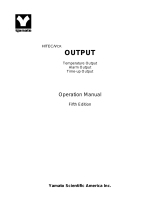
4
Control Method V/F Control
Frequency Setting Resolution
Digital Reference: 0.01 Hz (Below 100 Hz), 0.1 Hz (Over 100 Hz)
Analog Reference: 0.03 Hz / 50 Hz
Frequency Accuracy Digital: 0.01 % of Max. Output Frequency, Analog: 0.1 % of Max. Output Frequency
V/F Ratio Linear, Square Patter, User V/F
Overload Capacity 150 % of Rated Current for 1 Min. (Characteristic is inversely Proportional to Time)
CONTROL
Torque Boost Manual Torque Boost (0 ~ 15 %), Auto Torque Boost
Operation Method Key / Terminal / Communication Operation
Frequency Setting Analog: 0 ~ 10V / 4 ~ 20 mA Digital: Keypad
Start Signal Forward, Reverse
Multi-Step Speed Up to 8 Speeds Can Be Set (Use Multi-Function Terminal)
Multi Step Accel/Decel Time
0 ~ 9,999 sec, Up to 4 Types Can Be Set and Selected for Each Setting (Use Multi-
Function Terminal), Accel/Decel Pattern: Linear Pattern, U Pattern, S Pattern
Emergency Stop Interrupts the Output of Inverter
Jog Jog Operation
Input Signal
Fault Reset Reset Faults When Protective Function is Active
Operating Status
Frequency Level Detection, Overload Alarm, Stalling, Over Voltage, Under Voltage,
Inverter Overheating, Running, Stop, Constant Speed, Speed Searching
Fault Output Contact Output (A, C, B) – AC250V 1A, DC30V 1A
Output Signal
Indicator
Choose One From Output Frequency, Output Current, Output Voltage, DC Voltage
(Output Voltage: 0 ~ 10V)
OPERATION
Operation Function
DC Braking, Frequency Limit, Frequency Jump, Second Function, Slip
Compensation, Reverse Rotation Prevention, Auto Restart, PID Control
Inverter Trip
Over Voltage, Under Voltage, Over Current, Inverter Overheating, Motor Over
heating, Input/Output Phase Loss, Overload Protection, Communication Error, Loss
of Speed Command, Hardware Fault
Inverter Alarm Stall Prevention, Overload Alarm
Protection
Momentary Power Loss
Less than 15 msec: Continuous Operation,
More than 15 msec: Auto Restart (Programmable)
Operation Information
Output Frequency, Output Current, Output Voltage, Frequency Value Setting,
Operating Speed, DC Voltage
Display
Keypad
Trip Information Indicates Fault when Protection Function Activated, Memorizes Up to 5 Faults
Ambient Temperature
-10 °C ~ 40 °C (14 °F ~ 104 °F),
CE Certification: 41 °F ~ 104 °F (5 °C ~ 40 °C)
Storage Temperature
-20 °C ~ 65 °C (-4 °F ~ 149 °F)
Ambient Humidity
Less Than 90 % RH Max. (Non-Condensing),
CE Certification: 5 ~85% (Non-Condensing)
Altitude / Vibration
Below 1,000 m · Below 5.9m/sec² (=0.6g)
Application Site No Corrosive Gas, Combustible Gas, Oil Mist, or Dust
Environment
Atmospheric Pressure 70 ~ 106kPa
Cooling Method Forced Air Cooling
4
4
‘Self-cooling’ for model SV004ACtionMaster -4, SV008ACtionMaster -4.























